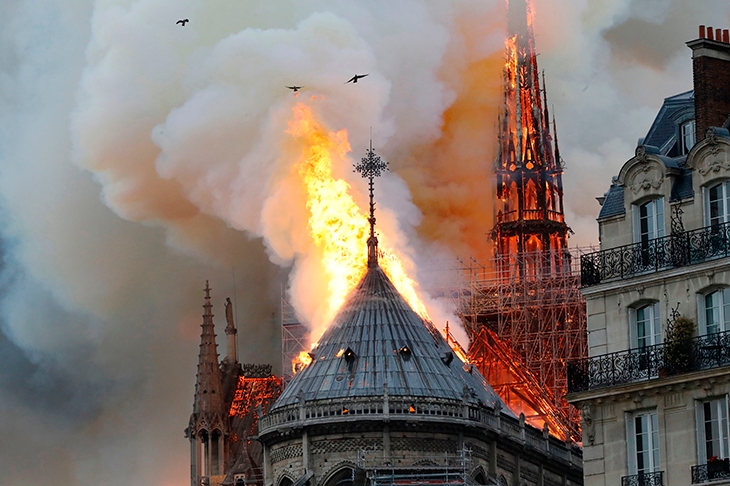‘Great edifices, like great mountains, are the work of centuries,’ wrote Victor Hugo in Notre-Dame de Paris. ‘The man, the artist, the individual, is effaced in these great masses, which lack the name of their author. Human intelligence is there summed up and totalised.’ The foundation stone of the cathedral of Our Lady of Paris was laid 850 years ago, but it was the work of generations, and took 200 years to complete. It soon became one of the greatest churches in Christendom and, as such, was ripe for desecration by the Jacobin fanatics of the French Revolution. In 1793, its altar was torn out in a ceremony that was too grotesque even for Robespierre. Napoleon reinstated Notre Dame as a cathedral in order to have himself crowned there, but the building soon fell into a state of hideous disrepair — which Hugo’s 1831 novel brought to the world’s attention.
Hugo’s musings on the soul of Notre Dame seem painfully relevant after this week’s calamity. He writes of ‘the successive engrafting of many arts at many levels’ that happens naturally over time when great cathedrals are built: ‘The service of religion once assured and provided for, architecture does what she pleases. Statues, stained glass, rose windows, arabesques, denticulations, capitals, bas-reliefs — she combines all these imaginings according to the arrangement which best suits her.’ Much of what Hugo describes is now lost or gravely damaged. Even the spire has gone, though not for the first time: the original had to be removed after it was damaged by wind. What collapsed on Monday was a 19th-century reconstruction, but that will hardly console the people of France. The agnostic President Emmanuel Macron spoke for his nation when he said that he had watched ‘part of us’ burn.
For French Catholics, the wider Catholic church and Christians in general, the wound goes deep. Many would have seen the damage to Notre Dame as symbolic of the broader gutting of the French Church by the forces of modernity. Christianity appears to be dying: churches are empty even on Sundays, religious institutions are moribund, and traditional belief is dismissed as an embarrassing superstition. Catholic France has suffered more than most: research suggests that young French people are more profoundly irreligious than their contemporaries in the UK. In France, only 7 per cent of young Catholics go to Mass, compared with 17 per cent in Britain.
But the pattern of decline spreads across Europe: a recent survey found that, on most of the Continent, a majority of those aged 16 to 29 said they had ‘no religious affiliation’ whatsoever.
It becomes all too easy, then, to see the burning of Notre Dame as a metaphor for the demise of a great faith and even of western civilisation. For the religious, the temptation may be to despair.
But despair is not the Christian, or the correct, response. As Tom Holland argues in his article, Christianity is a faith that finds strength in weakness and adversity. The Notre Dame fire broke out during Holy Week, when Catholics, Orthodox (according to their different calendar), many Anglicans and some Protestants cover holy objects in purple to commemorate the suffering of Jesus. Christians may feel that the near-destruction of one of Christendom’s greatest churches also symbolises suffering; but a suffering church, even one deserted by the populace or damaged by fire, is still the Church — against which Christ promised that the gates of hell will not endure. On the morning after the fire, pictures from within the smouldering cathedral showed that a golden cross had survived the blaze unharmed. This is the Easter story — one of destruction followed by hope.
Hugo glimpsed this truth when he wrote in Notre-Dame de Paris that the artistic ‘foliage’ of a cathedral rests on the ‘immovable’ trunk of the church’s design as a place of worship. This week the ‘trunk’ of Notre Dame was not destroyed; the main structure is intact.
Macron, whose finest hour this has been, said on Monday night: ‘We’ll rebuild this cathedral all together and it’s undoubtedly part of the French destiny and the project we’ll have for the coming years. That’s what the French expect because it’s what our history deserves.’ He added that Notre Dame was the ‘epicentre of our lives’ and spoke of its importance not just to France, but to the world.
That reconstruction project is already under way: huge donations are flooding in. Notre Dame has been remade before and can be again. For those looking for metaphor, this is surely it: that fire is not a sign of decay, it destroys but it also purifies and cleanses. The spire of Notre Dame will rise again — all the more moving for being resurrected.






Comments